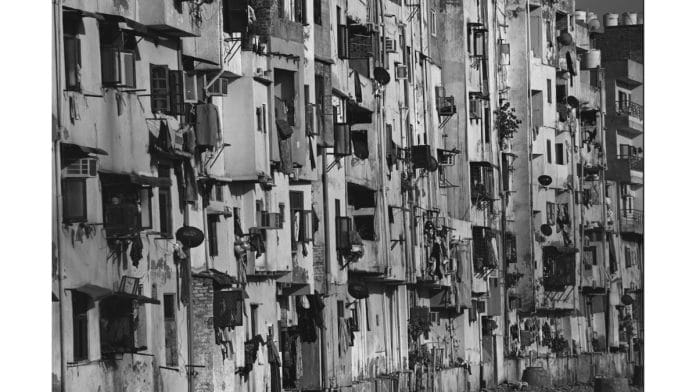New Delhi: Delhi wears its ruins like jewellery, its tombs like lullabies. In every stone, there is rhythm, a heartbeat. This is the terrain that photographer Rajeev Srivastava walks gently in his exhibition Taana Baana, his camera a witness to time, mood, and meaning.
“This is a city that has existed timelessly—at least for two to four hundred years—and yet there are these quiet, fleeting moments that often go unnoticed. That’s what I wanted to capture: a Delhi without the crowd, without the noise. A city that continues to exist even in the absence of its people,” Srivastava told ThePrint.
In Taana Baana (Interwoven), filmmaker and photographer Rajeev Srivastava captures the layered rhythms of Delhi through the poetic gaze of vintage lenses. His images—ranging from solitary streets to cosmic blooms—reveal a city alive with contradiction and charm. Unlike most exhibitions, this one resists a single theme.
Held at LTC Gallery, Bikaner House, and inaugurated by actor and politician Shatrughan Sinha, the exhibition invites viewers to pause, peer closer, and rediscover Delhi as a living tapestry of stories—each frame a strand in its evolving weave. The exhibition is on display till 29 April.

A city and fleeting wonders
The exhibition is a poetic interplay between the ancient and the intimate. Framing dancer Nikolina Nikoleski in Delhi’s Sultanate monuments, Srivastava evokes ‘poetry in stone’. These structures—domed, silent, enduring—become co-actors in a dance of shadows and stillness.
“I framed dancer Nikolina Nikoleski in empty, historic spaces—places rarely seen without crowds. At odd hours, their emptiness becomes a presence of its own,” he said.
But Srivastava’s lens does not linger only on the monumental. It seeks faces, too—those of family, friends, and fleeting strangers. His portraits are not posed, but paused. Shooting mostly wide open under F2.8, he isolates subjects from the noise of their surroundings, presenting them in painterly light.
His cityscapes are just as revealing. Using vintage lenses and a minimalist style, Srivastava treats Delhi not as a spectacle but as a familiar friend.
Be it the slow, solemn dignity of a centuries-old tomb or the restless urgency of a traffic-lit street, he captures the city in transition. His compositions are neither rushed nor manipulated—they unfold as quiet conversations with space. Urban spaces, strong and storied, seem to watch him through the thousand windows that are their eyes.
“Faces are rare here by design. I wanted to reveal the city’s soul—not through its people, but through its silences, contrasts, and empty spaces, where modernity and tradition, slums and wealth, quietly coexist,” he said.
Also read: British photographers showed sites of 1857 violence, without people. They erased Indians
Journey through lenses
During the quiet months of the lockdown, Srivastava stumbled upon two discoveries that changed everything—vintage lenses and eBay.
“I knew a little about these vintage manual prime lenses,” he said, referring to fixed-focus lenses from an earlier era that require manual adjustment. The Russian Helios 44, known for its signature swirly bokeh, became his gateway. “What fascinated me was the way these lenses revealed the character of a subject—and that’s what pulled me back into photography, with a new eye.”
He was soon captivated by the history behind the lenses. “There is a story behind these legendary Russian lenses,” he explained. “Like Jupiter, Industars, AES, Zenitars—and the craziest of them all, TAIR-3S, made like a sniper rifle,” he said. Many were based on Zeiss designs taken by the Russian army after WWII. “They were made in billions—they are still very cheap.”
What followed was a period of obsession and joy. He shot everything—portraits, wasps, bees, flowers, butterflies, hedges, trees. “It was pure magic,” he said. His collection expanded to include Pentax, Nikon, Zeiss, Olympus and more. “I was buying so many that my daughter got worried, and she said, ‘How will we ever buy a house if we just keep buying lenses?’”

Eventually, he realised that auto-focus and zooms weren’t giving him what he wanted. “It was basically these vintage lenses and the difference that got me into clicking pictures seriously,” he said.
The most meditative section is his floral series—dewdrops, petals, light, and air. In these photographs, he captured tiny blooms suspended in shafts of light, their ephemeral beauty heightened by the elusive bubble bokeh he loves so dearly.
The exhibition is about presence. About seeing the world not as it demands to be seen, but as it reveals itself in stillness. Srivastava, with his patient and loving eye, invites us to pause and look again. What we find, perhaps, is not just a city or a face or a flower—but ourselves.
“Most exhibitions follow a theme. Taana Baana doesn’t. The city itself is one thread, and the vintage lenses another. Everything is interwoven. That’s why the name. It’s not just about Delhi—it’s also about how I see it, through the character of these old lenses.”
(Edited by Theres Sudeep)






